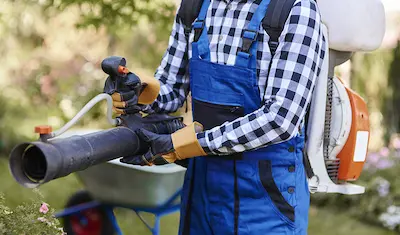How to Use a Leaf Blower Safely and Efficiently

Leaf blowers are an essential fall clean-up tool. But you shouldn’t just blow and go—follow these pro tips and tricks on how to use a leaf blower safely and efficiently.
- Wait until the leaves are dry: Wet leaves are sticky and difficult to blow around. Wait at least 24 hours after a rainstorm before you break out the leaf blower.
- Close windows and doors: If your family is enjoying the crisp fall air, ask them to pause for a moment and close the windows and doors. This helps keep out the noise and any dust you might pick up.
- Remove large items: Walk through the yard where you plan to use your leaf blower and pick up any loose objects, such as twigs, gardening supplies, and kids’ toys. Also, push large items out of the way that could impede your progress.
- Protect yourself: Safety glasses, gloves, sturdy boots, and noise-reducing earmuffs are a must.
- Create a plan: Before you start, decide on a path. To avoid blowing leaves back over an area you have already cleaned, start at one end of your yard and work your way toward where you are planning on depositing the leaves.
- Start up the blower: If this is a cold start, let the motor idle for a minute or so to help it warm up. (This is not necessary if you’re using an electric blower.)
- Move in a semi-circle: Rather than blowing the leaves in a straight line, funnel them toward a central point using an arcing pattern.
- Blow along walls: When working near the deck or side of your house, blow along the wall. If you head straight toward it, you’ll end up with debris blowing back in your face.
- Pull back on the throttle: There’s no need to run the blower on full blast all the time. Little bursts of power can be really effective, not to mention more fuel-conscious and less noisy.
- Work with the wind: Blow leaves with the prevailing wind at your back so you work with it, not against it.
- Pick up piles as you go: Leaf blowers are finishing tools intended for more detailed work. They are not meant to relocate large piles of debris. So, as your leaves pile up, break out a rake and transfer the litter to a garbage bag. Then, resume blowing.
- Consider a battery-powered blower: Many leaf blowers are gas-powered, but cordless battery-powered models are lighter, quieter, and more evenly balanced. You can also skip the hassle of mixing and storing fuel—simply remember to charge the battery for a few hours before heading outside. Expect 20 to 30 minutes of operating time on a single charge.
- Consider adding a vacuum kit: Some blowers have a suction option, allowing you to pick up material rather than move it around.
- Recycle the leaves: When you’re done, add the leaves to your compost heap or use them as mulch in your garden beds.
Arrange Professional Leaf Removal
With these tips for using a leaf blower, you should be good to go! However, if you don’t own a leaf blower, or you dread the messy, time-consuming work, leave it to The Grounds Guys®. We perform a range of fall clean-up services, including leaf removal, composting, weed control, fertilizing, pruning, and much more. Contact us today for a free job estimate.
Once your yard is clean and leaf-free, keep mosquitoes at bay with services from Mosquito Joe. Did you know? The Grounds Guys is a Neighbourly company. Learn more about Neighbourly’s community of home service experts at Neighbourly.ca.
 Click to call
Click to call


